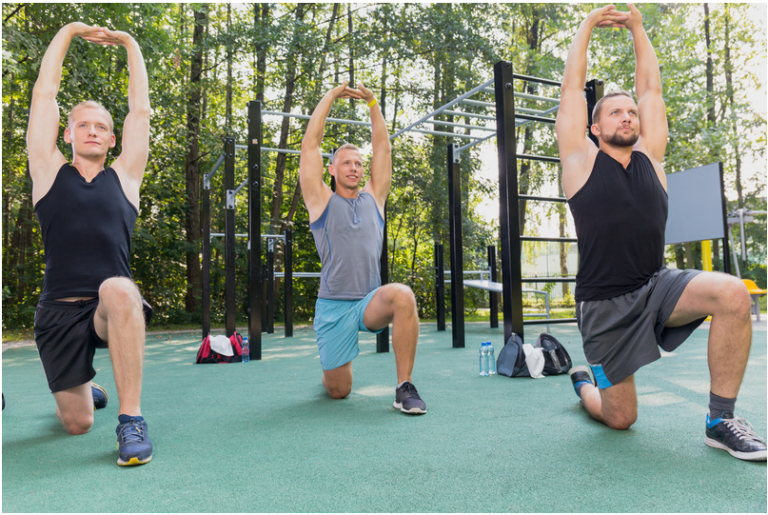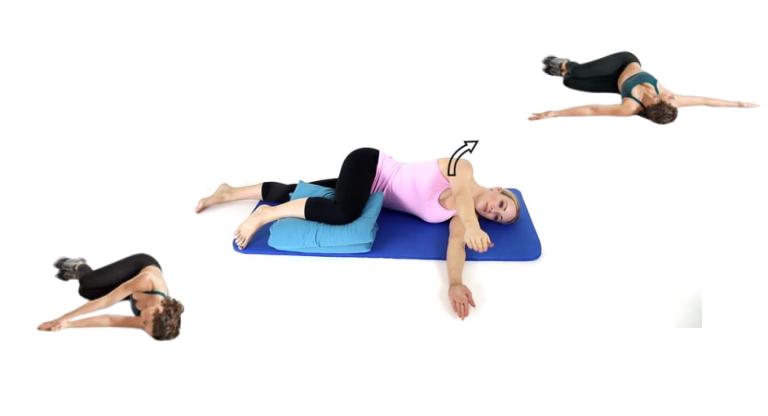
Stretching the Erector Spinae: How to Improve Your Posture and Relieve Back Pain

The erector spinae muscles are a group of muscles that run along your spine, from your pelvis to your skull. They help you bend, twist, and lift your torso and play a vital role in stabilizing your spine and maintaining good posture. However, many people suffer from tightness, pain, or spasms in these muscles due to poor posture, muscle strain, or a lack of exercise. Stretching the erector spinae muscles can help you relieve tension, improve mobility, and prevent injury. In this article, you will learn:
- What are the erector spinae muscles, and what is their function?
- How to stretch your erector spinae muscles with simple exercises
- How to strengthen your erector spinae muscles with effective exercises
- How to prevent erector spinae muscle problems with proper posture and ergonomics
This article is worth reading if you want to improve your posture, reduce your back pain, and enhance your spinal health. Read on to find out more!
What are the erector spinae muscles?
The erector spinae muscles are a group of muscles that run along your spine, from your pelvis to your skull. They consist of three main parts: the iliocostalis, the longissimus, and the spinalis. These muscles work together to extend, flex, and rotate your spine and support your spinal column and vertebrae. They also help you maintain an upright posture and balance your head on your neck.
The erector spinae muscles are essential for many movements, such as bending forward, twisting your torso, lifting objects, or arching your back. They also help you breathe by expanding and contracting your ribcage. However, these muscles can also become tight, weak, or injured due to various factors, such as:
- Sitting for long periods, especially with a slouched posture
- Lifting heavy objects with poor technique or without warming up
- Performing repetitive or strenuous activities that involve the spine, such as gardening, shovelling, or playing sports
- Having a sedentary lifestyle or a lack of physical activity
- Having a spinal condition, such as scoliosis, arthritis, or disc herniation
- Experiencing stress, anxiety, or emotional tension
What is their function?
When the erector spinae muscles are not functioning properly, you may experience symptoms such as:
- Back pain, especially in the lower back or between the shoulder blades
- Stiffness or reduced range of motion in your spine
- Difficulty standing or sitting straight
- Muscle spasms or cramps in your back
- Numbness, tingling, or weakness in your legs or feet
- Headaches, neck pain, or jaw pain
If you have any of these symptoms, consult your doctor or physical therapist to rule out any serious underlying causes and get a proper diagnosis and treatment plan. Stretching and strengthening your erector spinae muscles can be part of your rehabilitation and prevention program if you do it safely and correctly.
How to stretch your erector spinae muscles with simple exercises
Stretching your erector spinae muscles can help you relieve tension, increase flexibility, and improve blood circulation. Stretching can also reduce inflammation, promote healing, and prevent further injury. However, before you start stretching, you should:
- Warm up your muscles with light cardio, such as walking, jogging, or cycling.
- Avoid stretching if you have acute pain, inflammation, or infection in your back.
- Stretch gently and gradually without bouncing or forcing your movements.
- Hold each stretch for 15 to 30 seconds, and repeat 2 to 3 times on each side.
- Breathe deeply and relax your muscles as you stretch.
- Stop stretching if you feel any sharp pain, discomfort, or dizziness.
Exercises for the Erector Epinae Muscles
Here are some simple exercises you can do to stretch your erector spinae muscles:
- Child’s pose: This is a classic yoga pose that stretches your entire spine as well as your hips, glutes, and shoulders. To do this pose, kneel on the floor with your knees slightly wider than your hips and your toes touching. Sit back on your heels and lean forward, extending your arms in front of you and resting your forehead on the floor. You can also place a pillow or a folded towel under your forehead for comfort. Feel the stretch in your lower back and along your spine. You can also walk your hands to the left or right to stretch the opposite side of your back.
- Cat-cow pose: This yoga pose mobilizes your spine and stretches your erector spinae muscles. To do this pose, get on your hands and knees, with your hands under your shoulders and your knees under your hips. Keep your spine neutral and your head in line with your spine. As you inhale, arch your back and lift your chest and tailbone, looking up slightly. This is the cow pose. As you exhale, round your spine and tuck your chin and tailbone, looking down. This is the cat pose. Alternate between these two poses, moving with your breath and feeling the stretch in your back.
- Seated twist: This simple stretch rotates your spine and stretches your erector spinae muscles. To do this stretch, sit on a chair with your feet flat on the floor and your back straight. Place your right hand on the outside of your left knee and your left hand on the back of the chair. Gently twist your torso to the left, looking over your left shoulder. Keep your hips and legs still and your spine tall. Hold the stretch and then switch sides.
- Standing side bend: This stretch bends your spine sideways and stretches your erector spinae muscles. To do this stretch, stand with your feet shoulder-width apart and your arms by your sides. Raise your right arm over your head and bend your torso to the left, reaching your right hand towards the left side. Keep your left arm relaxed and your hips facing forward. Hold the stretch and then switch sides.
How to strengthen your erector spinae muscles with effective exercises
Strengthening your erector spinae muscles can help you improve your posture, support your spine, and prevent back pain. Strengthening can also increase your muscle mass, endurance, and power and protect your spine from injury. However, before you start strengthening, you should:
- Warm up your muscles with some light cardio and stretching.
- Avoid strengthening if you have acute pain, inflammation, or infection in your back.
- Perform the exercises with proper form and technique without holding your breath or straining your neck.
- Start with low intensity and repetitions, and gradually increase as you get stronger and more confident.
- Rest for at least one day between strengthening sessions to allow your muscles to recover and grow.
- Stop strengthening if you feel any sharp pain, discomfort, or dizziness.
Here are some effective exercises you can do to strengthen your erector spinae muscles:
- Back extension: This is a basic exercise that targets your erector spinae muscles, as well as your glutes and hamstrings. To do this exercise, lie on your stomach with your legs extended and your arms by your sides. Place a pillow or a folded towel under your hips for comfort. Engage your core and lift your chest and shoulders off the floor, keeping your neck neutral and your gaze down. Hold for a few seconds and then lower back down. Repeat 10 to 15 times.
- Superman: This is a more advanced exercise that works your entire back, as well as your glutes, hamstrings, and shoulders. To do this exercise, lie on your stomach, legs extended and arms stretched overhead. Engage your core and lift your arms, legs, chest, and shoulders off the floor, forming a U-shape with your body. Keep your neck neutral and your gaze down. Hold for a few seconds and then lower back down. Repeat 10 to 15 times.
- Plank: This is a core exercise that also engages your erector spinae muscles, as well as your chest, shoulders, and arms. To do this exercise, get into a push-up position with your hands under your shoulders and your legs extended. Engage your core and keep your body straight without sagging or arching your back. Hold this position for as long as you can, breathing normally. You can also modify this exercise by placing your elbows or knees on the floor for more support.
- Bird-dog: This is a balance exercise that challenges your erector spinae muscles, as well as your glutes, hamstrings, and shoulders. To do this exercise, get on your hands and knees, with your hands under your shoulders and your knees under your hips. Engage your core and keep your spine neutral. Lift your right arm and left leg, extending them in opposite directions, parallel to the floor. Keep your hips and shoulders level and your head aligned with your spine. Hold for a few seconds and then lower back down. Repeat with your left arm and right leg—alternate sides for 10 to 15 repetitions.
How to prevent erector spinae muscle problems with proper posture and ergonomics

Preventing erector spinae muscle problems is better than curing them. One of the best ways to prevent erector spinae muscle problems is to maintain proper posture and ergonomics at work and home. Here are some tips to help you improve your posture and ergonomics:
- When sitting, choose a chair that supports your lower back and allows your feet to rest flat on the floor. Adjust the height of your chair so that your knees are slightly lower than your hips. Keep your back straight, and your shoulders relaxed. Avoid slouching or leaning forward. If you use a computer, position the monitor at eye level and the keyboard and mouse close to your body. Take frequent breaks to stand up, stretch, and walk around.
- When standing, keep your feet shoulder-width apart and your weight evenly distributed. Align your ears, shoulders, hips, and ankles in a straight line. Tuck your chin slightly and pull your shoulder blades together. Engage your core and glutes to support your spine. Avoid locking your knees or shifting your weight to one side. If you have to stand for long periods of time, use a footrest or a stool to alternate your feet and relieve pressure on your back.
- Choose a mattress, pillow, and bedding that suit your comfort and preferences when sleeping. Avoid sleeping on your stomach, as this can cause your spine to arch and your neck to twist. Try sleeping on your back or your side, with a pillow under your head and another one between or under your knees, to maintain the natural curve of your spine. You can also use a rolled towel or a small pillow to support your lower back or neck.
- When lifting, use proper technique and avoid lifting objects that are too heavy for you. Bend your knees and hips, not your back, and keep the object close to your body. Engage your core and glutes and lift with your legs, not your back. Keep your back straight and your head up. Avoid twisting or jerking your spine while lifting if you must move the object and pivot with your feet, not your waist. If the object is too heavy or awkward, ask for help or use a tool, such as a cart or a dolly.
Summary
The erector spinae muscles are a group of muscles that run along your spine, from your pelvis to your skull. They help you bend, twist, and lift your torso and play a vital role in stabilizing your spine and maintaining good posture. However, these muscles can also become tight, weak, or injured due to various factors, such as poor posture, muscle strain, or a lack of exercise. To prevent and treat erector spinae muscle problems, you should:
- Stretch your erector spinae muscles regularly with simple exercises such as child’s pose, cat-cow pose, seated twist, and standing side bend.
- Strengthen your erector spinae muscles with effective exercises such as back extension, superman, plank, and bird-dog.
- Maintain proper posture and ergonomics when sitting, standing, sleeping, and lifting.
Following these tips can improve your posture, relieve your back pain, and enhance your spinal health. Remember to consult your doctor or physical therapist before starting any new exercise program, especially if you have any existing back conditions or injuries. Happy stretching and strengthening! 😊
FAQs
Q: What are the benefits of stretching and strengthening the erector spinae muscles?
Stretching and strengthening the erector spinae muscles can help you improve your posture, relieve back pain, and enhance your spinal health. Stretching can also reduce inflammation, promote healing, and prevent further injury. Strengthening can also increase your muscle mass, endurance, and power and protect your spine from injury.
Q: How often should I stretch and strengthen the erector spinae muscles?
A: The frequency of stretching and strengthening the erector spinae muscles depends on your goals, needs, and preferences. However, a general recommendation is to stretch at least 2 to 3 times a week and strengthen at least two times a week, with at least one day of rest between sessions. You can also stretch before and after strengthening exercises to warm up and cool down your muscles.
Q: What are some common mistakes to avoid when stretching and strengthening the erector spinae muscles?
A: Some common mistakes to avoid when stretching and strengthening the erector spinae muscles are:
- Stretching or strengthening when you have acute pain, inflammation, or infection in your back
- Stretching or strengthening without warming up or cooling down your muscles
- Stretching or strengthening with poor form or technique, such as holding your breath, straining your neck, or bouncing or forcing your movements
- Stretching or strengthening too hard or too fast, causing pain, discomfort, or injury
- Stretching or strengthening without consulting your doctor or physical therapist if you have any existing back conditions or injuries
Q: What other ways exist to prevent and treat erector spinae muscle problems?
A: Some other ways to prevent and treat erector spinae muscle problems are:
- Maintaining proper posture and ergonomics when sitting, standing, sleeping, and lifting
- Using a massage ball, a foam roller, or a professional massage therapist to release tension and tightness in the erector spinae muscles
- Applying heat or ice to the affected area to reduce pain and inflammation
- Taking over-the-counter pain relievers, anti-inflammatory drugs, or muscle relaxants as directed by your doctor
- Seeking medical attention if your symptoms persist, worsen, or interfere with your daily activities
References
- Effects of Core Stabilization Exercise Programs on Changes in Erector Spinae Contractile Properties and Isokinetic Muscle Function of Adult Females with a Sedentary Lifestyle: This study found that core stabilization exercises reduced stiffness in the erector spinae, increased the velocity of erector spinae contraction, and improved the isokinetic muscular function of the trunk.
- How to Practice 6 Yoga Poses to Strengthen and Stretch the Erector Spinae Group: This article explains how to perform six yoga poses that target the erector spinae muscles, such as child’s pose, cat-cow pose, and plank. It also describes the benefits of these poses for spinal health and posture.
- Erector Spinae, Physiopedia: This article provides an overview of the anatomy, function, and clinical relevance of the erector spinae muscles. It also suggests exercises and interventions for erector spinae muscle problems, such as myofascial release, lumbar stabilization, and stretching.



